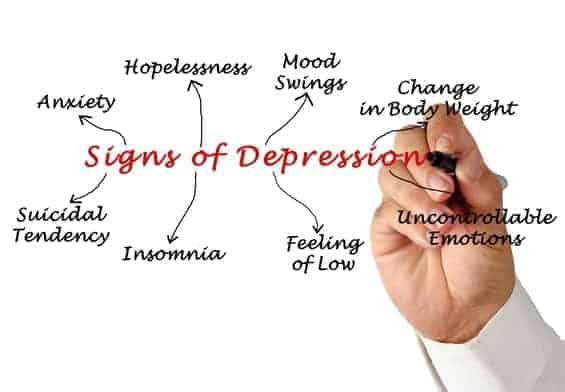
Very often, people take for granted that they can naturally maintain good mental health. Sometimes they feel sad during certain periods of time. However, it is important to recognize when the symptoms cross the line into Major Depressive Disorder (MDD), also called major depression or clinical depression.
Major Depressive Disorder is a pervasive and often misunderstood condition that can manifest with a wide range of symptoms. Major depression may start mildly. Initially, individuals can only complain of symptoms such as sleeplessness and lack of energy.
However, a fully developed Major Depressive Disorder is always associated with profound sadness, loss of appetite, low energy level, a pervasive sense of apathy, and an inability to execute everyday decisions. As a result, an individual’s overall lifestyle gets significantly impaired. MDD can persist for weeks, months, and even years, depending on the clinical picture and severity.
For More Information Contact CHMC
Call CHMCSigns and Symptoms of Major Depressive Disorder (MDD)

Major Depressive Disorder, also called “major depression,” has a profound effect on people’s ability to function normally. Affected individuals feel “pressed down” in their mood and vitality, not being able to master their daily routine.
Psychiatrists count depression to the category of “affective disorders” because it affects how you think and feel. Depression influences emotions and energy levels. Other associated symptoms are sleeplessness, underlying anxiety, and sometimes even delusions. MDD frequently appears in phases, called episodes, which continue for weeks or months, sometimes for years.
Recognizing the signs and symptoms of major depressive disorder begins with a thorough psychiatric evaluation. At CHMC Dubai, our German-trained specialists perform comprehensive assessments, including patient interviews, physical exams, and diagnostic tools. In more complex cases, your psychiatrist may recommend lab tests, EEG, or MRI scans to rule out physical causes contributing to depression.
What is Major Depressive Disorder?
It is a serious mental health condition characterized by persistent sadness, loss of interest, and often emotional numbness. When these symptoms recur, it may be classified as recurrent depressive disorder, requiring long-term care and monitoring.
Our clinic specializes in German Major Depressive Disorder diagnosis in Dubai, ensuring every patient receives personalized attention. Based on your symptoms and history, your psychiatrist will prescribe the most effective major depressive disorder treatments, typically involving medication with minimal side effects and evidence-based psychotherapy.
The goal of treatment is not just symptom relief but full recovery and prevention of relapse. Trust CHMC’s German board-certified psychiatrists to guide you through your mental health journey with compassion, precision, and clinical excellence.
Categories of Major Depressive Disorder
Medical specialists determine the severity based on well-defined parameters. Recognizing the various forms and degrees of depression is crucial for appropriate diagnosis and treatment. Tailoring interventions to the specific intensity, duration, and type of the condition can greatly enhance the well-being and chance of full recovery.
Category based on varying levels of intensity
MDD manifests in various forms and varying levels of intensity. Clinically, there are three distinct severity levels of depressive disorders: mild, moderate, and severe episodes.
Category based on course of the Illness
Furthermore, doctors categorize depression and its extent based on the course of the illness. Therefore, we can classify these conditions into three distinct timeframes.
- single depressive episode
- recurring depressive disorder
- long-lasting (chronic) depressive disorder
Criterion of Life Situation in Major Depressive Disorder
In addition to the temporal course, different life situations must also be considered. An example is seasonal depressive disorder, which predominantly occurs in the autumn and winter months and is referred to as seasonal affective disorder.
Furthermore, depression often occurs in women immediately after childbirth, during the postpartum period, or during pregnancy. The suffering experienced by affected women is significantly high in these cases.
Diagnosis of Major Depressive Disorder
A diagnosis of depression is based on the signs and symptoms developed by the patient. Typical symptoms are low mood, fatigue, loss of appetite, and sleeplessness. In severe cases, patients suffer from loss of affect (feelings and emotions) and experience a slowdown of thinking (brain fog). In such a state, the patient is not able to feel happy or sad but feels “numb.”
DSM-5 provides specific criteria for diagnosing MDD. An individual must exhibit at least five symptoms from the list below during the same two-week period, reflecting a noticeable change from their usual functioning. Among these symptoms, a depressed mood or loss of interest or pleasure must be present. Symptoms caused by other medical conditions must be excluded
DSM 5 Criteria of Major Depressive Disorder

The current classification systems, DSM 5 and ICD 10, categorize depression based on the severity of the symptoms and code them as mild, moderate, or severe. The phenomenological description based on the description and quantification of symptoms does not tell us anything about the underlying root causes.
The second key step in the diagnostic procedure is identifying the frequency of episodes (single or recurrent episodes) and the presence or absence of delusions.
Symptoms of Major Depressive Disorder include:
- Depressed mood: present most of the day, nearly every day, characterized by feelings of emptiness, hopelessness, or observations by others.
- Loss of interest or pleasure: markedly diminished interest in almost all activities most of the day, nearly every day.
- Significant weight changes: weight loss or gain (at least 5% of body weight in a month) without dieting or noticeable changes in appetite. For children, this may appear as a failure to gain expected weight.
- Sleep disturbances: insomnia or hypersomnia nearly every day.
- Psychomotor changes: Observable agitation or slowed movements nearly every day, beyond a subjective feeling of restlessness or sluggishness.
- Fatigue: A near-daily loss of energy.
- Feelings of worthlessness or guilt: excessive or inappropriate guilt, potentially delusional, occurring nearly every day.
- Difficulty concentrating: reduced ability to think or make decisions, as observed by oneself or others.
- Suicidal thoughts: recurrent thoughts of death, suicidal ideation without a specific plan, or a previous suicide attempt.
Additional Symptoms
In addition to the symptoms above, Major Depressive Disorder diagnosis requires:
- Symptoms cause significant distress or impairment in social, occupational, or other important areas of functioning.
- Episodes cannot be attributed to the physiological effects of substances or medical conditions.
- Symptoms are not better explained by schizoaffective disorder, schizophrenia, or other psychotic disorders.
- There is no history of manic or hypomanic episodes unless those episodes were induced by substances or a medical condition.
MDD is a complex condition that can significantly impact quality of life, but with proper diagnosis and treatment, individuals can be fully cured.
Social Impact of Major Depressive Disorder
Depression leads to mental and physical inhibition (mental block) that impairs a patient’s social and occupational functioning. In consequence, depressed people are often unable to carry out even the simplest daily activities. They cannot keep their apartment clean or maintain personal hygiene. Other symptoms include feelings of helplessness and social self-isolation. Patients with depression often experience decreased or complete lack of sexual interest (loss of libido), leading to problems in their marital life.
Feelings of Guilt and Inferiority
The main themes of depression relate to the person’s spiritual salvation’ and material and health condition. The person might believe he is the greatest sinner (guilt delusion), or he might claim to be utterly poor despite his good financial situation (poverty delusion). Patients overestimate negative events. Pleasant experiences have no effect. Depressed people tend to feel guilty and inferior to others.
Social Withdrawal

A common symptom of MDD is social withdrawal with involuntarily and significantly reduced regular social contacts.
Whether the lack of social interactions is externally imposed or stems from internal inhibitions is irrelevant. Initially avoiding situations like large gatherings can lead to a spiral towards complete social isolation. Thus, social avoidance can not only be a symptom of depression but also trigger it. For instance, there is a significantly higher prevalence of depressive symptoms among adolescents who reported having no close friends.
The approach to overcoming social isolation depends on the reasons behind its occurrence, which often involve a combination of factors. The lack of contacts can have far-reaching consequences. In many cases, psychotherapy is the preferred method to stop the vicious circle by addressing underlying emotional issues.
Major Depressive Disorder. Summary
Patients with major depression, especially those with a severe episode, appear deeply distressed, with tears in their eyes, downturned corners of the mouth, slumped posture, lack of eye contact, an immobile face, and limited body movements. In some patients, the depressive state is so profound that they seem frozen or petrified, unable to feel anything, and describe the world as colourless and lifeless. Some depressed patients also neglect their personal hygiene as well as the care of their loved ones.
Depressive episodes can often be quickly alleviated or mitigated with modern treatment methods, significantly improving the quality of life. However, in more than 50% of cases, an untreated or poorly treated major depression turns into a chronic condition. Each depressive episode increases the risk of subsequent episodes, and discontinuing treatment raises the likelihood of recurrence.
The key components of treatment include the use of antidepressants, psychotherapy, or a combination of both. For mild depressive phases, psychotherapy is as effective as medication. However, psychotherapy typically takes longer to show effects compared to antidepressants. For severe depressive episodes, treatment with medication is the first-line therapy, followed by counselling or psychotherapy.
Read More About Depression
- Self-Assessment Test for Depression
- Post Partum Depression
- Dysthymia. Diagnosis and Treatment
- Catatonic Depression
- Types of Depression
- Causes of Depression
- How To Avoid Depression
- Antidepressants in Treatment for Depression
- Depression caused by Physical Illnesses
- Psychotherapy for Depression
- How To Avoid Depressive relapse
- How Does Depression Develop
- Relaxation Techniques in Therapy for Depression
- Psychotherapy for Older Adults with Depression
- From Early Understanding to Modern Diagnosis of Depression
- Antidepressants. What They Are
- Feeling Depressed? Effects of Loneliness and Social Isolation


